Back to page 1
The Exterior
When SRG and Hoffman sat down to design the new ballpark, they weren’t starting with a blank slate. That’s because the chosen site already had a football stadium that dominated its surroundings in the recreation complex.
And that football stadium was going to sit just a few feet away from the new ballpark. “That was one of the more exciting aspects” of designing the park, according to SRG’s Yrazabal.
Swaim, representing the construction side of the design team, said, “Early in the process, we decided to expand the plaza between the two stadiums. This was the unifying piece between the two facilities.” This meant that there would be “one grand entrance for both stadiums.”
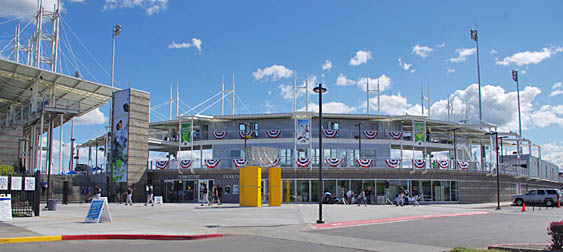 |
| Here is the ballpark from directly behind home plate, as seen from the parking lot with Hillsboro (football) Stadium on the left |
With a common entryway, that meant that the exterior of the ballpark needed to be compatible with the outside of the football stadium. The designers didn’t feel the need to duplicate the exact building materials and colors from the gridiron facility, but their use of grayish block comes pretty close. This is quite visible in the ballpark’s exterior behind home plate and, as shown on the left below, first base. And just as the football stadium has corrugated steel outer walls at its highest level, the baseball park also uses this material on its middle and upper levels.
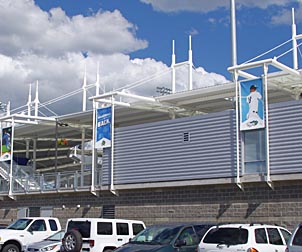  |
| Concrete block forms the exterior of the lower level, while corrugated steel faces outward from the second level. On the right, this is what motorists on 229th Avenue see as they drive by the park. Yes, there are large nets to catch home-run balls before they reach the street. |
As you look into the park from 229th Avenue beyond right and center field, you’ll be surprised that you can clearly view the playing field. Not only are there fences instead of walls, there are very few ad signs that block your view. Similarly, when you’re at one of the other playing fields or at the playground in the center of the Complex, you can see the action inside Hillsboro Ballpark. And to keep the sense of openness intact, the concourse behind third base is separated from the rest of the Complex by a see-through iron fence.
The one-and-only entryway for the ballpark is on street level at that entry plaza. Because the main concourse of the park is elevated, the lower level of the facility contains team offices and the merchandise store. Their doors open onto the entry plaza.
This plaza is special for another reason: The Barometer. That’s the name of a sculpture by local artist Devin Field, whose famous One World One Dream sculpture greeted fans as they entered the main Birds Nest National Stadium at the Beijing Olympics. The Barometer is quite a feast for your eyes and ears, as there are numerous devices at its center for kids to clang on. However, as it gets dark, you see the real magic of the piece, as multi-color LEDs illuminate the bowl at its top, triggered by sounds from the ballpark or from the clanging kids below. The City commissioned the piece, and the ownership of the Hops helped pay for it.
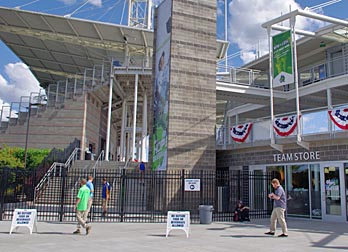 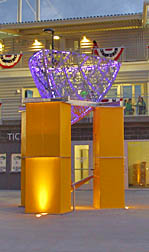 |
| On the left is a shot of the entry plaza for both the football stadium and the ballpark. The Barometer statue is shown on the right as the sun starts to set. That’s when you’ll notice the pulsating LEDs that are triggered by sounds from the park. |
Because the roof of the park is very visible from the outside, let’s discuss it here. Clearly, it is designed to be compatible with the distinctive roof on the football stadium. The ballpark’s “roof structure relates to the football stadium’s roof,” says Swaim. “The result is a cohesive complex but where each facility has its own unique character.”
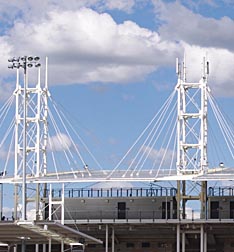 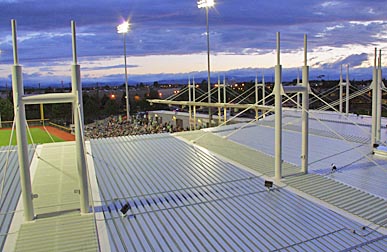 |
| The shot on the left was taken from beyond the outfield of the ballpark, looking back at the huge roof of the football stadium. The ballpark’s roof is much smaller and requires fewer suspension cables. The shot on the right was taken from the upper concourse of the football stadium. |
The football roof is much larger and requires more cables to hold it up. The white towers supporting those cables are large, elaborate and have attractive lighting. The towers on the baseball side aren’t as fancy, but they are definitely in the same family. They look quite appropriate, as if they are part of a younger sibling of the football structure.
Before we venture inside the beautiful new ballpark, let’s meet some of the folks who made this place happen.
|
The key players behind Hillsboro Ballpark
|
|||
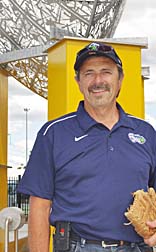 |
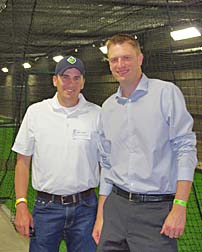 |
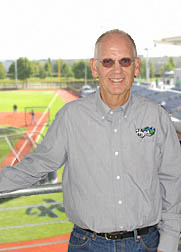 |
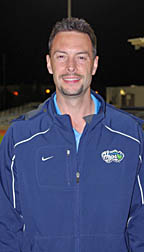 |
|
From left: Hillsboro Mayor Jerry Willey; Hoffman Construction’s Matt Swaim and Jeff Yrazabal of SRG, the two firms that designed and built the park; Hops’ Owner and President Mike McMurray; K.L. Wombacher, Hops’ GM and the sparkplug who was so relentless in obtaining a beautiful new home for his team.
|
|||
The Design
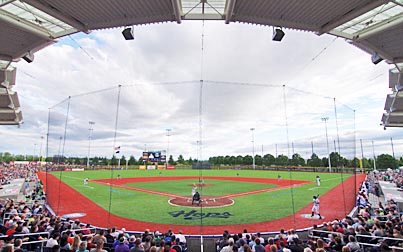
The roof isn’t the only distinctive feature of this ballpark. In fact, to the folks who designed it, the roof isn’t even the most important feature. No, this critical aspect was something that grew out of necessity.
As architect Yrazabal points out, the chosen location for the new ballpark “was a really tight site.” The immense backside of the football stadium’s grandstand seemed to loom over the space where baseball was to be played, encroaching on its personal space. How to create separation from that huge facility with so little space to do so? That’s when the light bulb popped on, and it did so brightly.
Forget separation. Instead, embrace that big football stadium, and make it part of the baseball experience. “The result of this decision was that we placed the top row of the baseball stadium on the same level as the football stadium’s (main) concourse,” Yrazabal revealed. “This allowed there to be a large plaza in between the two stadiums, and let us utilize existing football concession stands.”
“We spent so much effort maintaining the relationship between the two stadiums,” added Swaim. “The plaza was the key to it.”
 |
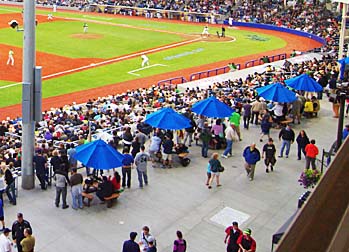 |
| The concourse that joins the two stadiums is indeed grand. You’ll find it all along its length: covered tables; numerous concession stands; group areas; and even rest rooms (that technically are within the football structure, but that are easily accessible while you’re at a baseball game). The shot on the right is looking down on the concourse from the upper walkway of the back of the football grandstand. | |
When a fan enters the entry gate and climbs the grand stairway, this broad concourse is the first thing he encounters within the ballpark. And it is an impressive sight, with a series of revamped concession stands (built into the back of the football grandstand) on your left, freestanding food and drink kiosks in front of you, and a gorgeous view of the playing field on your right. It’s enough to make a baseball fan instantly fall in love with the new facility.
This plaza is so wide and so long (stretching almost exactly to the point of the left-field foul pole) that numerous points of sale and small-group areas can fit — and leave plenty of space for fans to simply stand and visit. This also leaves room for more commercial opportunities in the future, like additional food carts.
The impressive concourse doesn’t end there. “We wanted an open concourse all the way around,” said Yrazabal. “Yes, there’s a 360-dgree walkway, but it was a challenge with the (tight) site.” For fans to walk all the way around the playing field, there is a grassy strip between the outfield fence and the outer perimeter of the park’s footprint. This wasn’t open on Opening Night because the grass wasn’t established enough to take the trampling it would’ve received, but when the grass is mature, it will give fans a view of the action that is seldom seen at a pro ballpark: looking through the outfield fence while standing of the same level as the players on the field.
While taking a stroll in between the fences, you’ll discover that you’re only inches away from the relief pitchers. Yrazabal pointed out that “in the Minors, there’s a greater connection between the player and the fan, and we wanted this to be especially true around the bullpens.”
 |
 |
| The only berm in the park wraps around the left-field foul pole. It’s certainly popular, but note that there’s no clear pathway through the mass of fans. On the right, the visitors’ bullpen is quote close to the spectators on the outfield side of the berm. | |
In order to reach this grassy walkway from the grand concourse, you have to traverse “one of the things we are most excited about, and that’s the berm. We think it will really be enjoyed by families coming to games,” Yrazabal continued. This grassy hillside wraps around the left-field foul pole, and can accommodate approximately 800 fans. One problem I discovered, though, is that there is no walkway at the front or the rear of the berm, and when it’s crowded you have no clear path to move through the masses, because they are sitting on the ground all the way up to the outer fence.
The main seating bowl consists of 3,700 seats (thankfully they’re blue instead of the ubiquitous dark-green seats you see everywhere), 270 of which are located directly behind the backstop. Naturally, this area is called the Home Plate Club. The only way you can access the center aisle in the middle of these seats is by first going through a private lounge area with bars and food. This area is only available to the Club ticket holders. This also helps restrict access to these premium seats.
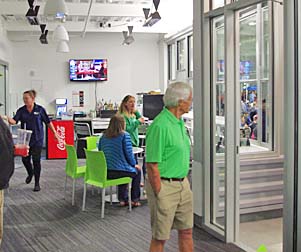 |
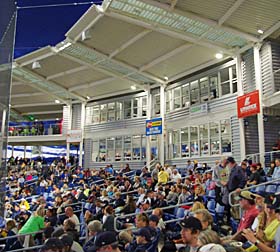 |
| The enclosed lounge is only for those with Home Plate Club seats. On the right, you can see those seats, and in the very center of the shot are the windows of that lounge. Note that the curving roof above the seats is actually a series of panels joined by a translucent material. | |
On each side of this enclosed lounge area is an open (but covered) area for small groups or, as was the case for Opening Night, overflow seating for the media.
The seats in the infield are mostly covered by the beautiful roof. The roof isn’t a straight, solid plane like at the football stadium. No, on the baseball side, the curving covering is actually a series of very attractive panels.
On the first-base concourse, there are two concession stands, but they don’t face the field like at most parks. “We turned the stands so lines that form are parallel to the concourse” and won’t block the path of other fans, Yrazabal pointed out.
The uppermost level of the park is accessed by stairs at either end, or an elevator that runs from just inside the entry gate on the street level up past the main concourse to this level. There is space for the writing-press and broadcasters, although by no means would you call the space “ample.” There’s also a surprise on this level: no luxury boxes! That’s right: there are no enclosed suites here. Instead, the team preferred two open party decks. The structure is such that suites can be added later if there’s demand, but the management of the Hops is right on the money about this: today’s groups prefer space that is more open where it’s easier to socialize. This was exactly the viewpoint of the Pensacola Blue Wahoos, whose new stadium was the Baseballparks.com Ballpark of the Year for 2012. There, the team elected to have a large, open dining area instead of suites on its upper level.
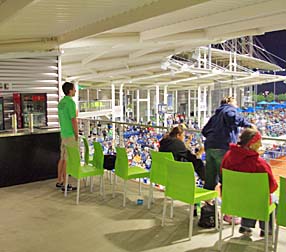 |
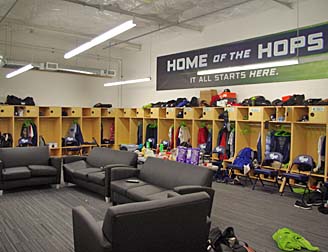 |
The ground level includes the merchandise store, the Hops’ offices and the “baseball” structures, such as the clubhouses, weight room, and batting cages. All of these are directly underneath the main concourse.
I know most new ballparks have natural grass, but that’s not the case here. This caused several of my Twitter followers to complain, but I pointed out to them that this facility is part of a City-owned recreation complex and will be used for a variety of events — baseball and otherwise. In the long run, this will be less expensive for the City than maintaining natural grass. Besides, this is Matrix Turf, which is the state-of-the-art in artificial playing surfaces. It is much more forgiving to athlete’s joints than previous incarnations of fake grass. It does take some getting used to, because the only dirt anywhere on the field is the batting circle and the mound — which is the same way PK Park in Eugene (which is also in the Northwest League) is configured.
The outfield dimensions are a fairly normal 325 down the lines and 400 to CF. The amount of foul territory in the infield is fairly typical, but it’s a little tight down the lines. This could be due to the restrictive space the designers had to work with and the desire to have the berm and the 360-degree walkway.
On an overall level, did the design team for Hillsboro Ballpark deliver the goods? Mike McMurray, one of the Hops’ owners as well as their president, remarked that the SRG-Hoffman team “listened to us, really listened to us.” This resulted in the owners being “just absolutely thrilled. We think things came out much better than we’d even hoped for.” It’s always smart to make the owners happy!
Does this arrangement of architectural elements work for folks who don’t own the team? After all, the goal was for the facility “to be the best ballpark possible for the fan and the players,” Swaim said. I think the stadium’s design (and turf) works wonderfully for baseball, and will probably also work well for the football games and other events that are planned for the ballpark. And are fans distracted by the much larger football stadium looming so close by? No. As Swaim points out, “You don’t even feel like you’re at a shared facility. When the (baseball) team is on the field, your focus is just on the baseball side.”
As it should be.
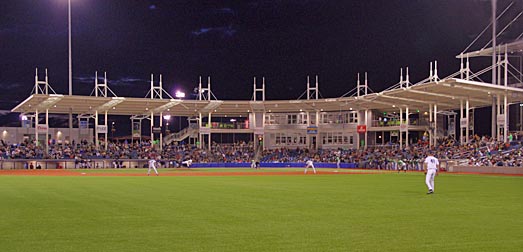
Now let’s look at what it’s like to attend a game at the new ballpark.
The Essentials
There’s definitely evidence that baseball fans in the Portland area were anxious for their favorite sport to return to the area, because they were out in force when the first pitch was thrown at Hillsboro Ballpark (photo below) … but what is their experience like when they venture to 229th Avenue in Portland’s western suburbs?
 |
|
First, let’s examine what it costs them. If the prospects of having to catch an extra shuttle bus after taking the MAX light rail isn’t appealing to you, you’ll be driving. It will cost you $5 to park in the lots that wrap around the north and east sides of the football stadium.
Seats in the Home Plate Club area are sold only as season tickets, which is too bad because you get unlimited food and non-alcoholic drinks with your ticket. It appears that all of those seats are sold out for the team’s inaugural season in Hillsboro. That leaves Lower Box Seats (these are the infield seats closest to the field and dugouts) for $16, while the rest of the box seats go for $14. Reserved seats on aluminum benches down the third-base line are $11 (see photo, below left), and general admission tickets — which typically means you’ll be on the berm — go for $7. Handicapped seating is in seven different clusters at the rear of the seats.
Do these ticket prices seem high to me? Yes, they do … however, I’ve always been surprised at how expensive seats are in the Northwest League, despite the fact that it’s only one notch up from Rookie ball. Let’s make some comparisons in the NWL. Hillsboro’s Lower Boxes are $4 more than comparable seats down Interstate 5 in Eugene, and the Field Boxes are $5 more than what the Emeralds charge. General admission tickets are $1 less in Eugene. Oddly, Hillsboro’s tickets aren’t that much higher than at Salem-Keizer, the NWL team less than an hour away, and their park is far inferior to the Hops’ new home.
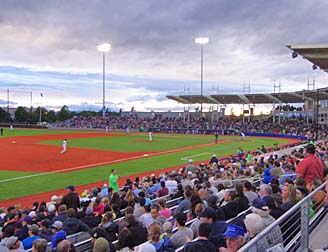 |
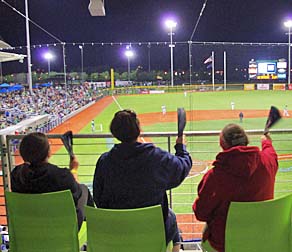 |
The Hops offer several attractive options for groups with at least 25 attendees. For $25 a person, you get all-you-can-eat ballpark fare (dogs and burgers) in the picnic pavilion at the far end of the grand concourse, and a reserved seat in the nearby aluminum benches. $900 will buy you exactly 25 tickets to one of the upper-level party decks, and all-you-can-eat burgers, dogs, beans, watermelon, cheese trays and more. An upgrade to the menu (to BBQ brisket and slow-roasted beef) bumps up the price to $1,125. Of course, the vantage point from those upper decks is fantastic.
And let’s talk about the concession choices for those not a part of a group. Ovations is the food-service vendor, and because the Hops agreed to invest funds in upgrading the kitchens behind the football-stadium’s concession stands, they are offering a staggering number of choices — and some really high-end menu options, too.
The Regional Vice President of Ovations is Tony Hendryx, and he floored me when he started describing all of the locally produced foods that are served at the stands in the park. “The whole line-up of hot dogs we serve comes from Zenner’s Sausage Company, which has been in business in Portland since 1927. The burgers are all made with certified Angus beef, and all of the buns come from Franz Bakery, which has been a local institution for 50-plus years. The cheese we use is from Tillamook, which is both a brand name and a town that is 55 miles west of here on the (Oregon) Coast, and all of their dairy products are famous. And when salmon season starts, we’ll have salmon dishes here as well. And the salmon will be fresh, never frozen.” He paused, then added, “Even the wood-fired pizza is cooked with local wood.”
Wow.
Hendryx also pointed out that the area is quite an “ethnically diverse part of the country, so we cater to that.” Have you ever heard of a ballpark serving a Pork Banh Mi sandwich — a Vietnamese dish with grilled pork and cilantro in an airy bun with a thin crust? They have it here for $9… even though the menu misspells it as “Bahn Mi.”
 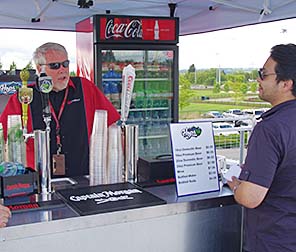 |
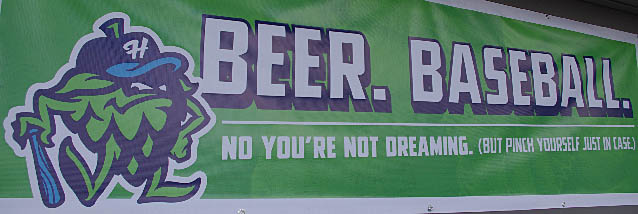 |
| Above on the left, the Tillamook Cheddar Bacon Cheese Burger is served with fries for $9 (photo courtesy of Ovations). The cleverly named BrewPen is on the first-base concourse. And part of the Hops’ marketing is to play up the long-standing relationship between beer — which is made with hops — and baseball. |
When I asked Hendryx what he would consider to be the ballpark’s “signature” food item, he laughed and said, “I would say beer! After all, we’re considered to be in ‘Beervana’ in this area, so we do offer some really nice craft beers.” One example would be Hop Czar by a Portland brewery named BridgePort. According to the company’s website, Hop Czar is brewed using “copious amounts of Nugget, Chinook, Cascade and Centennial hops.” Yes, even the hops are grown locally! I mean, it’s all about the hops in this ballpark, isn’t it? Even more impressive than this is that Bridgeport concocted a special ale just for Hops baseball fans. It’s called Long Ball, and it and Hop Czar can be found at the cleverly named BrewPen stand down the first-base line. A 16-ounce glass of either costs $6 and 20 ounces is $7.
When you’ve had your fill of the wonderful hops beverages, you can wander back down to the 670-square-foot Team Store, easily the nicest in the Northwest League. Again, it’s on the ground level by the entry gate. In fact, it has one door on the outside of the entry fence and one on the inside so the store can be open (say, in the offseason) when there’s no game going on and the gates are locked.
Director of Merchandise Lauren Wombacher is justifiably proud of the apparel and souvenirs. She told me that even before the team had played a game, they’d received online orders from 44 different states, Canada “and even an APO address.”
The prices are certainly reasonable. Short-sleeve adult T-shirts are $24 and long-sleeve T’s are $28. Polos are $56 (I couldn’t resist getting one for myself) and jersey tops are $75. Adult fitted caps are $30 and adjustable ones are $24. Kids’ T’s are $18 and $20, and caps are $16. If you’re from out-of-state and aren’t used to the way retail works in Oregon, you’ll be delighted when the price you pay at the register is the same one on the label, since there is no sales tax.
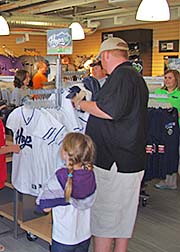 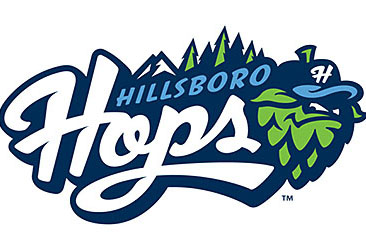  |
| The souvenir shop is attractively laid out with lots and lots of items with the adorable Hops logo (which is trademarked by Short Season LLC). |
The City and team “wanted a first-quality (video) board here, and we were able to provide them with a larger size and higher resolution than we’d first discussed,” said Steve Davis, who handles Oregon Sales for Daktronics, who manufactured the scoreboard. And it is exceptional, too, as even when hit by direct sunlight, the colors and contrast were still vivid. This is not the case with even some recent-vintage boards at other new ballparks. The video screen is 25 feet wide and 14 feet tall, and it sits atop a sharp “fixed digit” three-line linescore.
Similarly, the sound system is excellent, but it seemed to me the sound effects are over-used, sometimes after every pitch.
Although there’s a robust playground in the very center of the Gordon Faber Complex, it’s not accessible to youngsters at a Hops game. I asked K.L. Wombacher about this, and he told me that “we are planning a kids play area in year two. Our goal is to add something to the ballpark each year to keep people coming back.” Excellent plan, and helps spread out the expenditures over a longer period of time.
And I don’t often mention the exterior lighting of a ballpark, because often it’s an afterthought at a new facility. Not here. A lot of thought went into how the ballpark would appear to the outside world, and the lighting of the exterior walls and walkways is simply spectacular. When you include the really cool sculpture with its ever-changing colored LEDs, this place looks fantastic after dark. Nicely done.
 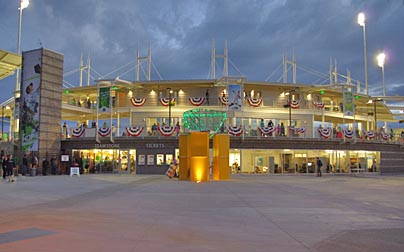 |
| The resolution and brightness of the video screen rival any in the sport. On the right, you can see just how nice the exterior looks once the sun starts to set. |
Fans are having a lot of fun at Hops games. Part of it is the ballpark itself, but much of it is due to the excellent game-day experience that the Hops staff provides for the attendees.
Summary
“This is not a functional game. It’s an emotional game. If you design a park to be functional, it will fail because it doesn’t take the emotion into account.” These are the words of Dennis Forsyth, Principal at SRG’s office in Seattle. Prior to joining SRG, he managed the design process for Safeco Field while at NBBJ. His credentials are not in dispute.
His point is an excellent one, because a ballpark shouldn’t just be a place where baseball is played. It needs to be where families enjoy themselves, where fans can get caught up in the action on the field. It needs to be fun. To me, this is where new Yankee Stadium in New York fails while Citi Field — in the same city, in the same year, by the same architecture firm — succeeds. One takes itself too seriously — while being a wonderful place for the National Pastime to be played — while the other has yet another fun attraction every ten feet. It’s a joy going to a Mets game, with all of its off-beat food stands and play areas for kids. Going to Yankee Stadium is like visiting a museum. No playgrounds, no whacky food, no dunking tanks.
Hillsboro Park succeeds, meaning it is fun. There are wide-open spaces for socializing, with no confined, pretentious luxury suites anywhere. There’s a nice berm for families. Unbelievable concession choices. Craft beers. A grassy walkway just outside the see-through outfield fence. And a nickname and logo that are the envy of pro baseball. Indeed, Forsyth’s firm did a great job partnering with Hoffman Construction to create this environment.
 |
| Following a game full of fireworks from the home team’s bats (Hillsboro won 12-0), Opening Night ended with a bang. |
It’s a place that might not have the same name very long, though, because K.L. told me that the team and City are looking for a naming rights sponsor. With taxpayers on the hook for much of the cost of this facility, that only makes sense.
What doesn’t make sense to me is this: How did the Hops end up with so much ballpark for such a small pricetag? Simply put, $15 million is a lot of money, but not as a budget for a ballpark in the affiliated Minors. Fans in the Portland area should be thrilled with the new home of baseball in northwest Oregon.
By the way, while Dennis Forsyth and I were having an earnest discussion about Hillsboro Ballpark, Safeco Field’s retractable roof and the state of baseball architecture in general, he kept glancing around the Club lounge. Finally he explained himself. “I have to make sure I grab one of the cookies when they bring more out.” When he was successful in that endeavor a couple of minutes later, he was positively beaming. After all, he came to Hillsboro Ballpark to witness the return of the sport to the area, and more importantly, he came to have fun.
He came to the right place.
If you’ve visited Hillsboro Ballpark and/or you have thoughts to share on it, please add a comment below.